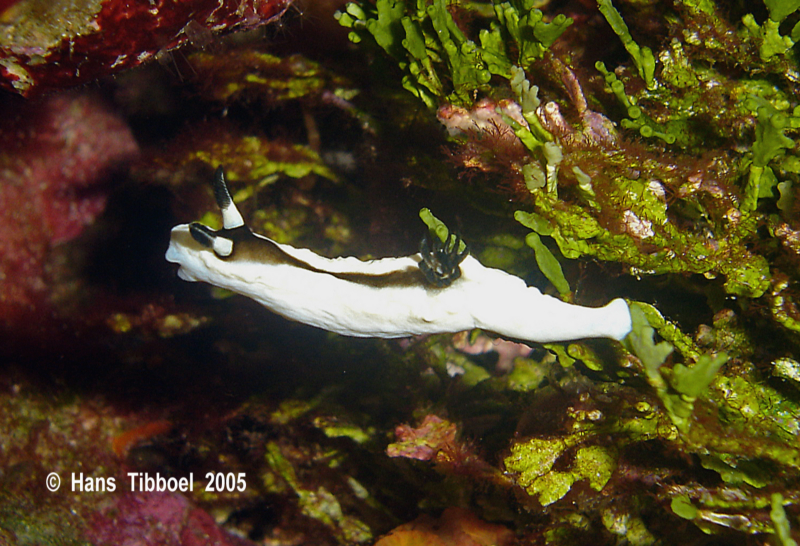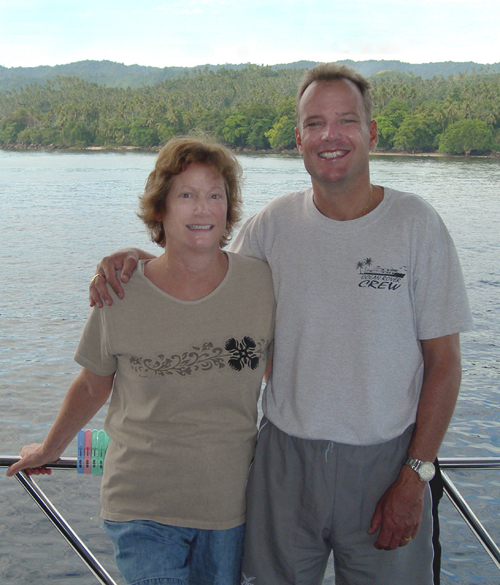 |
Glossodoris tibboeli
Photo courtesy of Hans TibboelGlossodoris tibboeli, Valdes and Adams, 2005
Have you ever wondered how new species get their names? In the case of Glossodoris tibboeli, the first species I have had the honor to name, it was an easy decision. During an Ocean Rover cruise to some remote, rarely dived islands north of Sulawesi, Indonesia in June 2004, Cruise Director Hans Tibboeli showed me a digital image of a nudibranch he had seen on the previous dive. Hans has a keen interest in opisthobranchs and can name almost any species in the places he usually dives, but he didn’t recognize this handsome black and white dorid and neither did I. We searched every nudibranch book in the ship’s library without finding a picture of anything with this distinctive pattern. It seemed like this slug was either a rare species or something new to science. Either way, I wanted to see it.
Fortunately, the next dive was scheduled at the same place, a submerged pinnacle several hundred yards from Para Island in the Sangihe Archipelago. This is not any easy dive. The currents that swirl around the pinnacle are sometimes so strong that most divers can’t swim or even pull themselves around to the front face. However, there was hardly any current when I entered the water in search of the mystery nudibranch. After an hour of searching I had not seen a single specimen and the current was beginning to pick up. Low on air, I had just started my ascent when I spotted twelve of the elusive beasts clustered together on a dark sponge. They were all approximately the same size and had identical markings. A closer look revealed three coils of white opisthobranch eggs among the slugs. I was so excited I almost forgot to shoot some photos before collecting a few specimens.
After I got home I e-mailed a picture of Hans’s find to Dr. Angel Valdes at the Malacology Dept. of the Museum of Natural History in Los Angeles and asked him for an ID. He responded immediately, saying that this was an undescribed Glossodoris sp. Angel was so sure that this was a new species that he asked me what I wanted to name it before he even looked at the specimens. I had already decided that if it proved to be a new species, it should be named honor of the guy who first noticed it, Hans Tibboeli.
A year later, Hans found many more G. tibboeli at Para Island. On one dive on the pinnacle he counted 100 specimens within a few square meters. After a few dives on the pinnacle, Hans discovered that the sponge this slug likes to eat grows on the side of the reef exposed to the strongest currents.
Although the eggs found near the specimens I collected cannot be positively attributed to G. tibboeli, it seems very likely that they are. If so, their large size (about 170 microns in diameter) explains why G. tibboeli is apparently endemic to a small area. Eggs this large usually develop directly into baby slugs that crawl away when they hatch, whereas most nudibranchs eggs hatch as veliger larvae that float around in plankton for several days, dispersing over a large area.
Reference:
Valdés, A. and Adams, M. J. (2005) A new species of Glossodoris (Mollusca: Nudibranchia) of the Glossodoris atromarginata Colour Group, from Indonesia. Pacific Science, 59: 603-608.
Mary Jane Adams and Hans Tibboel

Hans Tibboel; a short journey through time.
Born, basically on the beach, in the Netherlands in 1965, Hans Tibboel has had a close relationship with the sea ever since. As a kid he loved to spend time in the watershed areas close to the beach, play in and around the remains of the WW II West-Wall and (if water temperature permitting) swim in the North Sea on a summer's day. Hans became interested in scuba diving when he was a young adult but being not a big fan of cold water he never actually learned to dive in Holland. He discovered that working in an office was not his kind of life and future. Not really knowing what direction to take Hans decided to quit his job and go travel for a year. |
At an age of 24 he took his backpack and left home for the tropics. It would become the best thing he'd ever done in his life and give him opportunities that in Holland would not have been possible. Hans learned to scuba dive in Thailand and loved it from the first day on. He became (with help from some good friends) a PADI Scuba Instructor and worked and dived all over Southern Thailand.
His love for diving has also taken him into Myanmar, Malaysia, Irian Jaya and
Northern Sulawesi. Some of his most favorite marine creatures are nudibranchs but
Hans also has a great passion for sharks and rays. He's currently a PADI Master
Instructor, has logged well over 5000 dives and works as Cruise Director on the Ocean
Rover. Hans carries a small "point and shoot" digital underwater camera with build-in
flash and has learned the basics of Photoshop. He shoots pictures "just for fun" and
strongly believes that taking pictures should never compromise the well being of the
marine animals. Hans hopes to spend the rest of his life in Thailand doing what he likes
best; scuba diving and spending time with his wife and daughter.
Send Hans email at hans@ocean-rover.com
Send Mary Jane email at divepng@yahoo.com
